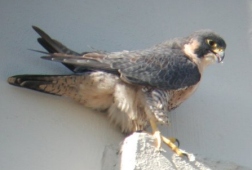
Medium robust falcon
with blue-gray upperparts, plain breast, heavily
barred sides, belly, and leggings.
Head has a black hood and sideburns. Yellow fleshy eye ring. Yellow
legs and feet. Feeds primarily on birds which it takes in midair after
a steep, swift dive from above them.

|
PEREGRINE
FALCON
Falco peregrinus
FALCONIFORMES
Falcons (Falconidae)
Range and Habitat
Peregrine Falcon: Breeds from Alaska and the Canadian arctic south locally
through the mountainous west, and sparingly in the east. Spends winters
on coasts north to British Columbia and Massachusetts. Preferred habitats
include tundra, savannas, coasts, mountains, and tall buildings.
SOUND: "kack-kack-kack-kack"
The Peregrine Falcon is the fastest bird on record when in diving posture,
called a stoop, at 175 mph or more. These falcons were given Endangered
Species status after decimation of the population from exposure to DDT
in insecticides. A successful recovery effort resulted in removal from
the U.S. list in 1999.
The Latin name “peregrinus” means “coming from foreign
parts” which is fitting because they have one of the longest migrations
of any North American bird.
A group of falcons has many collective nouns, including a "bazaar",
"eyrie", "ringing", "stooping up", and
a "tower" of falcons.
The Peregrine Falcon has an enormous range extending roughly 10,000,000
kilometers. This bird can be found in almost any part of the globe,
with the exception of Antarctica. Its habitats are nearly as varied
as geographic range and include forests, savannas, shrublands, grasslands,
wetlands and marine environments, desert areas and even urban locations.
The global population of this species is estimated to be around 10,000
to 100,000 individual birds. Currently, it is not believed that the
population trends for this species will soon approach the minimum levels
that could suggest a potential decline in population. Due to this, population
trends for the Peregrine Falcon have a present evaluation level of Least
Concern.

|





